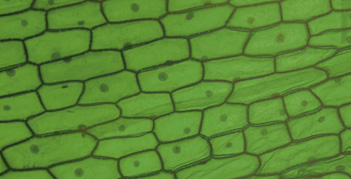The bonds that hold atoms together to form molecules are called covalent bonds. They are pretty tough and not easily made or broken apart. It takes energy to make the bonds and energy is released when the bonds are broken.
Trees take light and use it to make bonds between carbon atoms and molecules of cellulose. If we burn wood, those bonds are broken and we get heat and some light. But there is more to bonds between atoms than just energy—they are also what gives a molecule its shape.
Cellulose looks like long strings if you look at it with an electron microscope. These long strings of cellulose form bundles because of another kind of bonding called hydrogen bonding. The shape of cellulose molecules makes it easy for hydrogen bonds to form between strings. While not as strong as covalent bonds, hydrogen bonds are still pretty strong, so it is the shape of cellulose that makes wood a strong material.
NANOTECHNOLOGY AND MOLECULES
Nanotechnology can be used to make molecules. Atoms floating around in air or in liquid can sometimes bond to form molecules, but it isn’t that easy because of the rules about what can bond and what can’t.
Imagine taking Lego blocks and instead of fitting them together with your hands you stood across the room from your friend and threw them at each other to try to connect them. Every once in awhile they might stick together, but it could take a million attempts to get it to work once. If you have billions and billions of molecules, well, maybe it would work. So how many atoms are there, let’s say, in a bunch of air? Lots and lots, around 2.69 x 1019 molecules in every cubic centimeter. That’s 2,690,000,000,000,000,000,000 molecules.
THE FUTURE OF NANOTECHNOLOGY
But will we someday be able to make molecules like we build things out of Legos? Back about 30 years ago, a guy by the name of Eric Drexler proposed something like that, molecular machines that could make molecules. These machines are imagined to be able to take elements and stick them together to make molecules and bigger things the same way we make a car or a toaster. We are still a long way away from that kind of stuff and there is a lot of controversy—if it is even possible—only time will tell!

